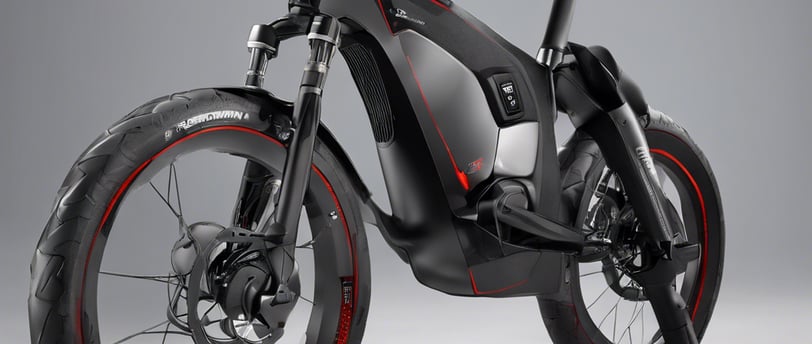Turn Every Ride Into an Adventure, Your Electric Freedom Awaits! 🚴♂️⚡ SHOP NOW! 🌍🚀
Maximizing Battery Life: Tips and Tricks for Your Electric E-Bike
Mathew James
6/28/20247 min read


Understanding Your E-Bike Battery
Electric e-bikes rely on various types of batteries, each with distinct characteristics that influence performance and longevity. The most commonly used batteries in e-bikes are lithium-ion, nickel-metal hydride, and lead-acid batteries. Among these, lithium-ion batteries are favored due to their high energy density, longer lifecycle, and lighter weight compared to the other types. Nickel-metal hydride batteries, while more environmentally friendly than lead-acid options, tend to have a shorter lifespan and lower energy density. Lead-acid batteries, though more affordable, are heavier and do not perform as efficiently as their modern counterparts.
Understanding critical concepts like battery capacity, voltage, and amp-hours is essential for proper e-bike usage. Battery capacity, measured in watt-hours (Wh), indicates the energy the battery can store. A higher watt-hour rating translates to a longer range or more energy available for your rides. Voltage, typically measured in volts (V), represents the electric potential of the battery and influences the power output. E-bikes commonly use 24V, 36V, or 48V systems. Amp-hours (Ah) denote the amount of current a battery can supply over an hour. For example, a 10Ah battery can provide 10 amps for one hour or 1 amp for 10 hours.
The lifecycle of an e-bike battery, defined by the number of charge and discharge cycles it can undergo before its capacity significantly deteriorates, is crucial for long-term use. Lithium-ion batteries generally offer between 500 to 1,000 charge cycles, whereas nickel-metal hydride and lead-acid batteries typically provide fewer cycles. Several factors, including temperature, charging habits, and storage conditions, can affect battery lifespan. Excessive exposure to heat, overcharging, or deep discharging can prematurely degrade battery health. By understanding and managing these elements, users can maximize their e-bike battery's lifespan and ensure consistent performance.
Proper Charging Techniques
Charging your electric e-bike battery correctly is essential for maintaining its longevity and ensuring optimal performance. A fundamental aspect of this process involves using the charger specifically designed for your battery type. Matching the correct charger to your battery prevents potential damage and maximizes the efficiency of the charging process. Always refer to the manufacturer’s guidelines to determine the appropriate charger for your e-bike.
Avoiding overcharging and undercharging is crucial to battery health. Overcharging occurs when a battery is plugged in long after it reaches full capacity, which can degrade the battery cells and reduce overall lifespan. Modern chargers often have built-in features to prevent overcharging, but it is still prudent to unplug the battery once fully charged. On the other end, undercharging—failing to recharge the battery before it depletes entirely—can also harm the cells. Maintaining a balanced charging routine helps preserve battery efficiency and durability.
Temperature plays a significant role in the charging process. Charging your e-bike battery at moderate temperatures, ideally between 20°C (68°F) and 25°C (77°F), optimizes the charging efficiency and safeguards against the adverse effects of extreme temperatures. Very high or low temperatures can negatively impact battery performance, potentially causing irreversible damage or reducing capacity.
When storing the battery for extended periods, keep it at an ideal state of charge, typically around 50% to 70%. This range helps in mitigating the stress on the battery cells during inactivity. Fully charging or discharging a battery before storage can accelerate degradation, so aiming for a mid-level charge is advisable. Additionally, store the battery in a cool, dry place away from direct sunlight or sources of heat.
Riding Habits to Prolong Battery Life
Optimizing the battery life of your electric e-bike begins with adopting the right riding habits. How you ride significantly affects your battery's longevity. One of the primary considerations is the pedal-assist level. Using a lower pedal-assist setting can dramatically increase your bike's range. Although higher settings offer more power and speed, they consume more battery. Therefore, finding a balance that suits your needs without excessive power drain is essential.
Maintaining a consistent speed can also conserve battery life. Constant acceleration and deceleration are taxing on your e-bike's battery, similar to how stop-and-go driving impacts a car's fuel efficiency. Aim to keep a steady pace to optimize energy use. Employing smoother, gradual changes in speed when necessary further enhances this efficiency.
Rapid acceleration, in particular, should be minimized. Quick, forceful starts require a significant burst of power, leading to quicker battery depletion. Instead, accelerate gradually whenever possible to ensure more efficient energy consumption. Conversely, avoiding sudden, aggressive braking can also save battery energy, as it reduces the need for frequent re-acceleration.
The terrain you ride on plays a crucial role in battery usage. Riding on hilly or mountainous terrains typically requires more power compared to flat surfaces. When facing steep inclines, try to employ a lower gear and a moderate pedal-assist level to avoid overtaxing the battery. Additionally, planning your route to minimize steep climbs can be beneficial.
Lastly, payload—or the weight you carry—affects battery consumption. Heavier loads demand more power from the engine, thus draining the battery faster. Limiting the weight you carry when riding, or distributing it evenly, can make a notable difference. Consider what's necessary for your trip and avoid carrying unnecessary items to optimize battery longevity.
Adopting these riding habits can significantly extend the life of your electric e-bike battery, allowing for longer, more enjoyable rides.
Regular Maintenance and Care
Regular maintenance and care of your electric e-bike are essential to ensure optimal performance and prolong battery life. One of the most fundamental aspects of routine maintenance is keeping the battery terminals clean. Over time, dirt and grime can accumulate around the terminals, leading to poor connectivity and reduced efficiency. Use a soft cloth and a mild cleaning solution to gently clean the terminals, ensuring that no moisture seeps into the battery casing.
Conduct a periodic inspection for any signs of wear and tear. Pay particular attention to the battery casing, connectors, and cables. Look out for signs of fraying, rust, or physical damage, and address these issues promptly. Damaged components can compromise the overall effectiveness of your e-bike’s electrical system, leading to potential failures or shortened battery life.
Another crucial aspect is keeping the battery and its connections dry and free from debris. Moisture is a common enemy of electric components and can cause significant damage if not properly managed. After riding in wet conditions, make sure to dry your e-bike thoroughly, especially around the battery area. Store your e-bike in a clean, dry place to minimize exposure to elements that could lead to corrosion or damage.
For e-bikes equipped with smart batteries, it is important to stay up-to-date with software updates and firmware maintenance. Manufacturers often release updates that can improve battery management, enhance performance, and fix bugs. Regularly check the manufacturer's website or connect your e-bike to the designated app to download and install any available updates. This will not only maximize the efficiency of your battery but also ensure that you are benefiting from the latest technological advancements.
By integrating these regular maintenance practices into your routine, you are taking crucial steps to protect your investment and get the most out of your electric e-bike. Consistent care and attention to detail can significantly extend the lifespan of your battery and maintain the overall health of your e-bike. Remember, a well-maintained e-bike is not just a joy to ride but also a reliable and cost-effective mode of transportation.
Enhancing Battery Performance in Extreme Conditions
Extreme weather conditions can have a significant impact on the performance and longevity of your electric e-bike's battery. Understanding how temperature fluctuations affect the battery and knowing how to manage these effects is crucial for maintaining optimal performance and prolonging battery life.
High temperatures, commonly experienced in summer months, can cause the battery to overheat, leading to reduced efficiency and potentially permanent damage. To mitigate these risks, it is advisable to store your e-bike in a cool, shaded area when not in use and avoid leaving it in direct sunlight for extended periods. Additionally, charging the battery in a temperature-controlled environment can help prevent overheating. Insulating the battery with protective gear can also serve as a barrier against extreme heat.
Conversely, cold weather can slow down the chemical reactions within the battery, reducing its capacity and runtime. During winter months, it is often beneficial to store your e-bike in a warmer place, such as indoors or in a heated garage. When riding in cold conditions, it is advisable to pre-warm the battery by storing it at room temperature before use. Insulated covers are also available that can help maintain the battery's temperature during rides, ensuring more consistent performance.
Both extreme heat and cold can lessen the lifespan of your e-bike battery if not properly managed. Therefore, regular inspections and maintenance are essential. Checking for any signs of wear and tear, such as swelling or corrosion, can help address issues before they escalate.
In conclusion, taking proactive steps to protect your e-bike battery from the effects of extreme temperatures is crucial. Through proper storage, use of protective gear, and maintenance, you can significantly enhance the battery's performance and extend its life, ensuring optimal functionality of your electric e-bike throughout the year.
```htmlUnderstanding Battery Replacement and Disposal
Recognizing the optimal time to replace your electric e-bike battery is crucial for maintaining peak performance and ensuring safety. A failing battery often exhibits a noticeable decline in performance indicators, such as decreased range per charge, sluggish acceleration, and extended charging times. Observing these signs consistently suggests it may be time for a replacement.
When selecting a replacement battery, compatibility with your e-bike’s specifications is paramount. Reviewing the e-bike's manual or consulting with the manufacturer can guide you in choosing a battery that meets the necessary voltage, capacity, and size requirements. Always opt for batteries from reputable brands to ensure quality and longevity.
The process of replacing the battery involves several critical steps. First, safely power off your e-bike and disconnect it from any power sources. Next, locate and remove the battery using the proper tools as outlined in the user manual. Install the new battery by positioning it correctly within the battery compartment and securely fastening it according to the manufacturer’s instructions. Finally, perform a test ride to ensure the new battery functions as expected, paying careful attention to the power output and charging behavior.
Environmentally friendly disposal of old e-bike batteries cannot be overstated. Due to the hazardous materials they contain, improper disposal of e-bike batteries can have severe environmental consequences. Many e-bike retailers and manufacturers offer battery recycling programs that adhere to strict environmental guidelines ensuring safe and responsible disposal. Alternatively, local recycling facilities generally accept e-bike batteries and adhere to environmentally sound practices.
By responsibly replacing and disposing of e-bike batteries, cyclists not only enhance their riding experience but also contribute to environmental conservation efforts. Ensuring a sustainable approach to battery lifecycle management promotes not just individual responsibility but also collective environmental stewardship.
```Address:
999 Charlotte Hwy, NC 28730, USA
Sales:
Email: sales@ecobikemachines.com
Call: (863) 272-9235
Subscribe to our newsletter
COMPANY
Online Support:
Email: support@ecobikemachines.com
Call: (626) 686-4545
